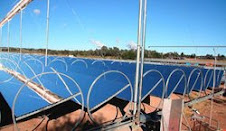Hanging On - Endangered Species in Ontario
TheStar.com - GTA - Hanging on
The province has identified the Jefferson salamander as a "threatened" species. The vulnerable Jefferson salamander just one of several species threatened by exemptions in protection act
July 04, 2008
Nick Kyonka, The Star.com
Staff Reporter
The Jefferson salamander is one species caught between the good and the bad of the new Endangered Species Act.
The first act in North America to protect both endangered species and their surrounding habitats, the act, which came into effect Monday, allows temporary exemptions from its guidelines for resource-driven industries.
The Jefferson salamander has been identified by the province as a "threatened" species, as opposed to "endangered." Under the old legislation, it would not have received full protection, but it is now one of 10 "fast-tracked" species to be fully protected as of next June.
In the meantime, however, the tiny amphibian is considered one of the species most vulnerable to the act's exemptions. The forestry industry has a one-year exemption, and there are three-year exemptions in place for the pits, and quarries and development industries. All threaten to destroy the salamander's woodland habitat across the province, environment groups say.
"It's been a bit of a poster child for development versus species protection," notes Caroline Schultz, executive director of the group Ontario Nature.
While the Jefferson salamander used to feature prominently in the GTA and across the province, years of development have stripped the species of much of its habitat. Pollution and predators have also slowly picked away at its numbers, and it now exists only in isolated pockets across the province.
Other species are in similar predicaments.
Yesterday we looked at seven endangered species that no longer can be found in the GTA. Today, we examine the GTA's nine currently endangered species.
AMERICAN COLOMBO
NATURAL HABITAT: Dry soil in deciduous forests, forest edges and thickets
HOW MANY LEFT IN THE GTA: One known population remaining
WHY THEY ARE AT RISK: The plant's sweet roots and vulnerability to invasive plants threatens its survival. Its roots can also be manipulated to resemble those of the popular American Ginseng, giving them value on the black market.
AMERICAN EEL
NATURAL HABITAT: North American freshwater lakes connected to major waterways
HOW MANY LEFT IN THE GTA: Unknown but dwindling population in Lake Ontario and its tributaries
WHY THEY ARE AT RISK: Much of the GTA's American eel population has been killed in large hydro turbines while travelling to and from the Atlantic Ocean to breed. Once a thriving species, as much as 99 per cent of its population has disappeared. For the first time ever, the American eel is listed as endangered across the province under the new act. ACADIAN FLYCATCHER
NATURAL HABITAT: Deciduous woodlands near creeks or wetlands
HOW MANY LEFT IN THE GTA: Fewer than five pairs
WHY THEY ARE AT RISK: Deforestation and fragmentation of woodlands have stripped the birds of their breeding grounds. Once a flourishing species in Ontario, an estimated half of the province’s remaining Acadian Flycatchers now live in protected areas, like provincial and national parks. AMERICAN GINSENG
NATURAL HABITAT: Large, moist deciduous forests
HOW MANY LEFT IN THE GTA: Several hundred plants in scattered forests across Durham, Halton and Peel regions
WHY THEY ARE AT RISK: Human consumption has been the biggest killer of American Ginseng in Ontario for generations as its roots are used in homemade medicinal tonics. Experts fear that if the few remaining patches of the plants are discovered, they will likely be wiped out quickly. KING RAIL
NATURAL HABITAT: Shallow freshwater marshes
HOW MANY LEFT IN THE GTA: Reported in three separate GTA wetlands
WHY THEY ARE AT RISK: The King Rail has paid a high price for development in the GTA, as construction from urban sprawl has wiped out the birds' habitat. For generations, the marshes they call home have been drained to make room for people. Pesticides are also suspected to have played a role. RED MULBERRY
NATURAL HABITAT: Moist, deciduous forest in the Carolinian forest zone
HOW MANY LEFT IN THE GTA: Five trees in the Niagara Escarpment in Burlington
WHY THEY ARE AT RISK: Natural and conventional destruction of habitat has all but eliminated the red mulberry in Ontario. The increased presence of the white mulberry — found naturally in Asia — has played a significant role in the tree’s gradual decline, as hybrid mulberries take over anywhere both trees are found. PURPLE TWAYBLADE
NATURAL HABITAT: Oak savannahs, woodland openings
HOW MANY LEFT IN THE GTA: One small cluster population in King Township
WHY THEY ARE AT RISK: Due to their vibrant purple tips, these orchids are popular garden items and are often dug out in clumps by collectors. Urban development has also depleted their stocks, as has the orchid's inability to grow in shade. AMERICAN CHESTNUT
NATURAL HABITAT: Deciduous forests
HOW MANY LEFT IN THE GTA: One known population remaining
WHY THEY ARE AT RISK: Ontario's American Chestnut population never recovered after an outbreak of the Chestnut Blight fungus in the 1970s. Though nearly 99 per cent have been wiped out by the fungus over the past 30 years, the trees remaining are believed to be resistant, giving rise to the hope of a future partial recovery. BUTTERNUT
NATURAL HABITAT: Deciduous forests
HOW MANY LEFT IN THE GTA: Hundreds of trees in scattered populations all across the GTA, but not for much longer
WHY THEY ARE AT RISK: Most of Ontario's butternuts are slowly dying due to a fungal infection called butternut canker, which spreads spores across the tree and attacks the tree from the inside out. An efficient killer of the species in the U.S. for decades, the fungus first reached Ontario in the early 1990s. A provincial exemption under the new ESA allows for the removal of the dying infected trees.
Suggested Surfing:
Alternative Energy Stocks, Solar Power Investing
Renewable Energy Investing, Windpower Stocks
Geothermal Energy Links, Geothermal Company Websites
The Toronto Sound - New Canadian Music
A Green Realtor Blog
Bees Trees Frogs Elephants Nature and Ecology Blog
New Canadian Singer Yuya
Best Green Stocks Investing Blog
Subscribe to:
Post Comments (Atom)
Yuya Joe Blog
Lake Ontario Waterkeeper
The Daily Beast -Politics Blog
21stArch.com - 21st Century Architecture
Original Joe College Blog
WikiLeaks Foreign Policy Analysis
AGreenRealtor.com Real Estate Blog - Ecology Energy Efficiency
Best Green Stocks Investing Blog
PV Intell Photovoltaic Solar Stocks Investing
SEARCH Leading Alternative Energy and Ethical Investing websites

Custom Search
Daily Kos
Rare Earth Stocks Research
Patrick MacManus's Blog Peace and Collaborative Development
BeesTreesFrogsElephants.com - Nature and Ecology Blog
Research Green Energy stocks, Clean Energy investing information
Find wind power investing info online, clean energy mutual funds, geothermal stocks, solar energy investments.

Green Energy Investing Network:
Green Stocks Investing Clean Power Blog
SolarIntell.com Renewable Power Investing Website
Wind Intell.com Wind Energy Stocks Company Links
Geothermal Power Investing Public Companies
PV Intell.com Leading Photovoltaic Solar Energy Stocks

Custom Search
Green Energy Investing Network:
Green Stocks Investing Clean Power Blog
SolarIntell.com Renewable Power Investing Website
Wind Intell.com Wind Energy Stocks Company Links
Geothermal Power Investing Public Companies
PV Intell.com Leading Photovoltaic Solar Energy Stocks







No comments:
Post a Comment